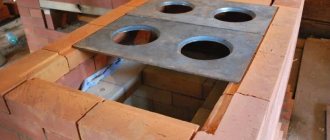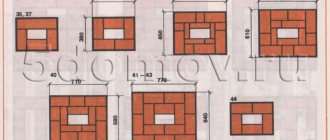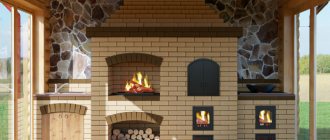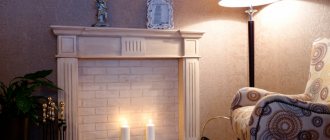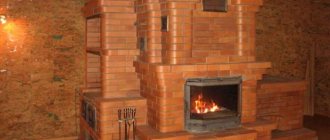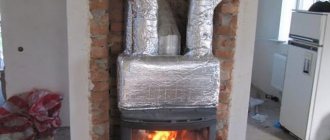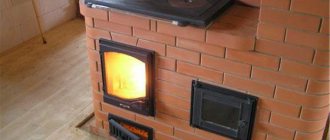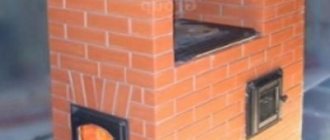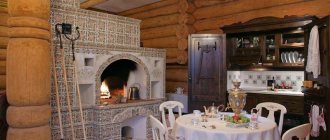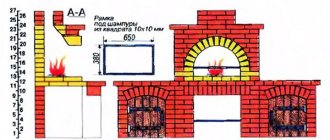A beginner who is first thinking about how to build a brick fireplace with his own hands will need a masonry diagram first of all. It is called ordering and allows even amateurs to solve this complex problem without going into calculations or delving into regulatory documents. There is no point in “inventing” a fireplace on your own without being an expert in this matter. But in addition to the ready-made order, the home craftsman will also need theoretical knowledge about the basic elements of the fireplace, the principles of its efficient and safe operation. All the necessary information is in front of you.
The warmth of a home cannot be compared with anything Source n1s1.hsmedia.ru
What you need for work
To make a fireplace for a home, two types of bricks are used: solid and fire-resistant. The inside is laid out last because it can withstand high temperatures. In addition, this type of brick is capable of storing heat for a long time and warms up slowly. For the solution, use a mixture that is sold in special stores or you can make it yourself using clay and sand. The consistency should be like thick sour cream.
If a wood-burning fireplace for a summer house is built with a closed firebox, then you will need doors made of metal and fire-resistant glass. You also need to buy a damper, a vent door and a cleaning door. For the chimney you will need a steel pipe.
Tools include a spatula, a construction level, a grinding machine, a tape measure, a container for mixing the mortar, a trowel, and fittings.
Note! For beginners, when cutting and chopping bricks, it is better to use a grinder with a circle along the concrete thread. Then there will be less waste and translation of material.
As soon as everything for the work has been assembled, they begin installing a wood-burning fireplace for the dacha with their own hands.
Materials
Directly affect the operation of the fireplace, its reliability and not causing discomfort during use. The quality of the brick determines how long it will last.
When choosing, take into account the following indicators:
- brand not lower than M200;
- absence of damage – cracks, lumps, broken parts and others;
- laying the outer contour with pink, solid brick;
- purchasing the required volume of one batch;
- making payments in advance;
- purchase for the boiler and chimney exclusively material that is resistant to high temperatures - heat-resistant fireclay or clinker type.
To successfully complete the task, you must know the amount of refractory bricks. In addition to this, the following should be available:
- oven clay;
- cement category M 300, M 400;
- purified and sifted sand with a fraction of up to 1.5 mm;
- crushed stone;
- smoke damper.
In addition, they stock up on reinforcing bars 70 cm in diameter, 1 cm in diameter, with a round profile, transverse protrusions and a pair of longitudinal ribs.
Types of brick structures
Before you build a fireplace in your country house with your own hands, you need to choose its type. There are several types of contraction, which depend on the installation method:
- Built-in.
- Wall-mounted.
- Angular.
- Island.
The style and type of fireplace depends on the wishes of the home owner and on the area of the room in which the structure will be erected.
Built-in type
A fireplace for a dacha of this type is built immediately during the construction of a wall or column. If you make a built-in structure in an already built house, then the costs will be higher. Since you will have to make a hole in the wall for the chimney and portal.
Of all the types, it takes up the least space. The portal or firebox is chosen in accordance with the area of the room. This size is 70x60 or 80x70 cm. The portal itself is framed with masonry or brick. If the area of the room is small, up to 20, then the size is 60x50 cm.
Wall type
It is installed against a wall where the chimney can be built into the wall or partially protruding. It can be built in a house with ready renovation, since it does not require the destruction of a wall. It is considered one of the popular types. It takes up a lot of space, so it won’t be possible to build it in a small room. The cladding is made of stone, tiles, bricks or other similar materials.
Corner type
They are popular because they are conveniently located, do not take up much space, and there is a lot of free space in front of the fireplace. The chimney of the structure is mounted in one of the adjacent walls. The part that remains open is made of concrete or metal. The front part itself is plastered or covered with decorative brick or stone. This type of fireplace creates additional coziness in the house, since chairs can be placed in a semicircle near it.
What to consider when designing a house made of profiled timber
Island type
In this case, the structure is erected separately from the walls, in the center of the room. Then the heat spreads evenly throughout the room. Its feature is an open firebox. True, sometimes the open space is covered with glass. Island fireplaces look impressive, but take up a lot of space. Therefore, they are installed exclusively in large rooms. Then they do not block the light and look appropriate and neat.
Briefly about the main thing
In order for a home hearth to effectively heat the room and not smoke, its dimensions must correspond to the area of the room, and the design must not disturb the main load-bearing elements of the house.
Before building a fireplace, a separate foundation is poured for it, which should be slightly larger in area than the area of the hearth itself.
It is recommended to build yourself according to ready-made order schemes, which take into account all the nuances of masonry.
The fireplace is built from ceramic bricks with clay mortar.
Determining the size of the structure
The initial stage of building a fireplace in a private house is determining the project parameters. The calculation is done separately with the help of a specialist, or they take a free ready-made drawing of a beautiful fireplace.
Note! If the structure is built with high-quality heating in mind, then choose the correct size of the firebox. Its dimensions are 1/50 of the total area of the room.
Drawing your own drawing is not such a long task. First, they measure the room where they plan to build the stove masonry. Secondly, they draw the structure itself, taking into account the scale. Thirdly, the firebox, portal and chimney with chimney pipe are calculated.
When calculating the parameters of the portal, possible smoke in the room is taken into account. To avoid this, adhere to the proportions of depth and height. For proper heat transfer, a ratio of 1:2 or 2:3 is suitable. The chimney opening is eight times smaller than the firebox area. In the chimney pipe, the diameter is selected up to 10 cm and the length is 5 cm.
Features of glass doors for cast iron models
Regular glass will not work. A material with a high heat-resistant index is used.
Glass door
Glass installation is carried out by specialists. Requires knowledge and skills.
The operational parameters of glass depend on the type of fuel. The maximum combustion temperature changes.
Door for cast iron unit
Detailed instructions and order
It is easier to build a fireplace with your own hands if you have a detailed description and photo of each installation stage. There are several stages that are followed during construction. Carrying out the work step by step, you can build a country stove-fireplace with your own hands.
Create a drawing
Regardless of the shape and configuration of the structure, the first thing they do is create a sketch and drawing of the future fireplace. Adhering to the scale on a piece of paper, draw the design, indicating all the elements of the device
It is important at this stage to choose the cladding. For example, if you plan to embroider the outer part, you will need red ceramic brick
And if the cladding will be done with tiles, then choose a more economical option.
What are frame houses and what are they made of?
Preparatory work
When installing a fireplace in a living room, cover all furniture and the floor with plastic wrap in advance. If the premises are not residential, then this is not done, but after construction work, they simply wash and clean everything thoroughly.
52654227f81b7b6fc0a54cf4c7e6e4a7.jpe
The next step is the construction of a foundation, on which the reliability of the structure depends. The foundation is made separate for the fireplace, rather than shared with the house. If the construction is being done in a residential building, then carefully remove the floor in the place where they plan to build a fireplace. It is made 6 cm larger than the structure itself.
They dig a hole 60 cm deep, fill it with 15 cm of crushed stone, fill it and form a base. The foundation is given 7 days to dry. Before building a fireplace, the bricks are first laid out dry without using mortar.
Note! During the process of laying bricks “dry”, each stone is numbered. This will allow you to build the fireplace faster.
Laying out the fireplace
As soon as the foundation has dried, lay out roofing material in two layers. For the first row of masonry, cement is added to the mortar in a ratio of 20% of the total volume of the mortar. The first brick row is laid edgewise. The equality of the diagonals is determined using a tape measure.
Continuous rows are built using a trowel. The chimney and firebox are built manually. The solution is applied to the middle of the brick. If there is excess solution, remove it with a damp cloth immediately before it dries.
After the foundation, a firebox is made. A grate is laid on the bottom, then rows of firebox are erected and the door of the fuel chamber is secured. To securely fix it, the door is placed on a metal mustache and laid between the rows. The blower is built on the fifth row.
The next step is the arch. Regardless of the design of the fireplace, steel corners are used when constructing the arch. Bricks are attached to them, and when facing they are hidden. When building an arch, the bricks are placed in a wedge.
Construction of a chimney
Whether smoke enters the room or not depends on a well-built chimney. If the smoke exhaust duct is round, then the draft is better, but if it is square, it is worse. The walls are made smooth so that soot does not form and smoke easily passes through the pipe. The chimney itself is made vertical, less often at an angle. In this case, the angle of inclination is no more than 30 °C. The size of the pipe depends on the size of the structure and the outlet channel. The minimum cross-section is 14x27 cm. A cap is installed at the top of the chimney, which protects it from precipitation and other parts.
Cladding works
If you build a regular or mini-fireplace with your own hands, then finish it with cladding. Decorate the outer part of the structure in several ways:
- Plaster. First, tighten the mesh and install U-shaped brackets. Drying oil is applied to protect against corrosion. The first layer of 5 mm plaster is applied to the warm wall. The second layer is applied after the first has dried. The thickness of the layer is made thicker than the previous one. The third layer is made with a thickness of up to 15 mm.
- Coloring. Use a chalk or glue solution.
- Drywall. It gives the fireplace a rectangular shape. First, a metal frame is made, and drywall is sewn onto it.
- Decoration.
Note! When painting the outer part of the fireplace white, it is recommended to add blue to the paint. Then the paint will be more snow-white.
806d9bee2ae82c964ba00b857b11994f.jpe 1f8683af01cdd717f398a2a01b5a2186.jpe
With the help of cladding, flaws that arose during the masonry process are hidden. If the work is done well, you don’t have to do any cladding.
Construction work
Since the masonry of the structure is done with wet bricks, it must be dried before lighting the fireplace. They do this for 6-7 days. Open the combustion door and ash chamber. Then the fireplace is lit to dry, but the temperature is not raised to maximum. During the second week, the structure is heated every day, without raising the temperature to the maximum.
Operating principle
Operating principle
The operating principle of a wood-burning fireplace for heating a home is quite simple to understand.
Dry wood, when burned, releases a lot of heat, which heats up the brick (stone).
He, in turn, having the ability to remain hot for a long time, shares heat gradually, over a long period of time, supplying the room with it.
The devices look different, but the irreplaceable parts, chimney and firebox, are available in any model. How to make your furnace more efficient?
A good working fireplace, with high efficiency, should be:
- not too deep and wide enough;
- To increase the efficiency factor, special heat shields are added to the design. Their role is played by massive parts that release a large amount of heat when heated:
- The masonry of a fireplace stove for a home is specially made with protrusions and irregularities, which increase the area of the heated surface, and, accordingly, heat transfer.
No matter how good a fireplace in a country house is, built with your own hands, it is only additional heating - in our climate it is not easy for everyone to do without a central system.
Rules for choosing a firebox
The metal firebox is equipped with a special pipe, so when choosing this option, the chimney pipe is selected in accordance with the diameter of the pipe.
Specialized stores offer a huge selection of fireplaces with fireboxes of any configuration. This can be open, closed, end-to-end or one-way. In addition, the firebox may have a built-in heat exchanger, allowing you to connect the fireplace to a water heating circuit.
The traditional option is a brick firebox. When deciding how to make a simple fireplace, it is recommended to use white fireclay bricks, which are resistant to high heat.
The brickwork must be level, so the work should be carried out with extreme care and precision. Setting up a brick firebox requires a lot of time and effort, requiring special skills, patience and endurance from the master.
Features of installing a cast iron model
It is recommended that installation work be carried out by specialists. But you can do it on your own.
The door can be purchased at the store. Installation features depend on whether the firebox is built into a finished structure or installed from the very beginning.
Door Designer door
Adjacent to the wall at one of the ends
Such models are recommended for fairly large or medium-sized rooms. By making a similar fireplace in your home with your own hands, you can zone the room or reduce the size of the passage between separate rooms.
A special feature of this option is the possibility of installing a through metal firebox with two-sided or three-sided finishing with heat-resistant glass. In addition, you can make a firebox on one side and decorate the back with natural stone.
In small rooms, you can also build a fireplace with your own hands, adjacent to the wall at the end. In this case, it allows you to divide one room into two functional zones, making your stay more comfortable.
Air loop system
The main idea of an efficient heating device is that convection in a fireplace allows air flows to be used as a coolant and distributed in several directions, which helps to warm up several rooms at once. It should be noted that a traditional fireplace gave off only a small fraction of energy in the form of radiation, and warm air escaped through the chimney.
An important element in the structure of such a fireplace is the body and air ducts. The housing allows you to localize warm air, playing the role of a kind of storage device, and air ducts are needed to transport it to the right rooms. In this way, the entire house is heated, and not just the room where the fireplace is located.
When wood burns, the wall of the firebox becomes very hot. The air, passing through the labyrinths and coming into contact with the surface of the walls, also increases its temperature. The heat capacity of air is low, so it manages to heat up to the desired state in a short time.
Placement of a fireplace in the bedroom
When constructing a wood-burning fireplace yourself, one nuance should be taken into account. In order for the air to heat up more efficiently, it needs to increase the contact area, that is, using a system of labyrinths, it will force it to travel a greater distance while inside the fireplace body. But such a number of bends will interfere with the natural convection that occurs due to the buoyant force. You will have to install special fans that are capable of pumping cold air into the firebox, displacing hot air.
Good to know: Beautiful fireplaces for the home, what interesting products will help decorate the interior
In order not to experience unnecessary noise from operating fans and to achieve a natural upward movement of masses, the layout of the labyrinths is significantly simplified. In any case, the heating fireplace is based on constant displacement by incoming air flows. Cold masses, falling down, push the air of the lower layers inside the fireplace body, and rising masses push warm air upward.
To ensure heating of the house with a fireplace, all that remains is to supplement the convection system with a distributor with air ducts. If all equipment installation work is carried out correctly, then the fireplace can become a full-fledged device for heating a country house.
Description of other popular types of fireplaces
Wood-burning fireplaces can be called a classic option, but there are other heating devices. They run on different fuels, their installation is simpler and takes a little time.
31645a5ab732723e3288a3142ba2e131.jpe 66abc9aa63ba679a7db6652699058198.jpe
In the store you can purchase ready-made fireplaces of the following types:
- Gas devices. Installing them is very simple, but to connect you need to invite a gas service specialist with special permission. In addition, written permission to install such a fireplace will be required.
- An electric fireplace can be installed not only in a private house, but also in a city apartment. You can choose a stationary model or a mobile device. Most stationary electric fireplaces are designed as a firebox with a beautifully designed portal. Fireplaces of this type are powered by mains power and do not require a chimney. Modern fireplaces are equipped with electronic panels, so to heat, switch or turn them off, just press the corresponding button on the remote control.
- Eco-fireplaces that use ethyl alcohol are gaining popularity. However, such fireplaces are not suitable for heating a room; they are purchased as a decorative element of the interior. They are designed to create comfort and a special atmosphere that can “warm the soul.”
- You can make a decorative home fireplace with your own hands from plasterboard sheets and a metal profile. There will be no fire or heat in such a fireplace, but in this case you can get decoration or a shelf for various accessories.
You can install or build a fireplace in your home with your own hands; the main thing is to choose the right model, learn how fireplaces are made, and also take care of fire and environmental safety.
Finishing
The finishing coat gives the fireplace a finished look. Before learning how to make fireplaces, it is advisable to immediately decide on the end result. There are several additional methods that may be useful:
- Plaster coating.
- Painting – what material to choose was described earlier.
- Facing can be done using artificial or even real stone.
Many people begin to experiment with the appearance by cutting off some parts of the brick. This not only destroys the integrity of the structure, but also defeats the purpose of the effort.
Basic principles of construction
- The first row is laid edge-on, and the subsequent rows are laid flat.
- The base is made of at least two rows.
- The brick is taken whole, without chips or cracks.
- Before laying, the brick is soaked in water so that in the future it does not take moisture from the mortar.
- The minimum seam thickness is 5 mm.
- The excess mixture is removed immediately before it has time to dry.
- The solution is made without lumps and should not be used to coat the inside of the fireplace.
- Installation is done during the warm period (spring or summer).
- Construction begins from the corners.
For the work, high quality materials, fireproof mortar and the required design are used. Cladding also plays an important role in creating additional comfort in the room.
Blueprints
Thanks to these drawings, you can imagine the design of fireplaces, which will help you build them without outside help:
Schemes of different fireplaces
Firebox diagram
Dimensions
Order
Bell stove-fireplace for 2 rows
Did the article help you?
Combustion chamber
There are open and closed combustion chambers. The closed structure must necessarily include additional components - a gate and transparent doors made of fire-resistant glass. The simplest option would be to purchase a ready-made combustion chamber - this will significantly simplify the installation work, and cast-iron closed fireboxes look very good.
Arrangement of the fuel chamber is one of the most problematic and difficult stages of installing a fireplace. The firebox located under the chimney must have a chimney tooth, which is necessary for the efficient operation of the entire structure. To extend the service life of a metal firebox, it is advisable to line its internal walls with fireclay bricks, which will minimize the contact of open fire with the chamber material.
Since the main working process takes place in the firebox, it is worth considering it now:
- The fuel is removed from the fuel basket, which is usually located under the firebox, and placed on a grate located in the chamber;
- The ignited firewood is set on fire, and the intensity of its combustion is regulated using a slide valve, which provides oxygen access to the working area (if the fireplace has an open firebox, the combustion process can only be changed by adding firewood);
- The burned fuel becomes ash and ends up in the ash pan, located directly under the grate (collected ash must be removed periodically, so the best option would be a retractable ash pan);
- The gas released during combustion goes outside through the chimney (for maximum efficiency, it is worth equipping the chimney with a forced draft, which will also allow you to regulate the heat transfer of the fireplace).
A special point is the masonry of the back wall of the fireplace. There are two common opinions on how it should be positioned. According to the first opinion, the back wall of the fireplace is simply laid out vertically. This option is extremely simple, but does not have any special features.
The second option is somewhat more difficult to arrange - it involves installing the back wall at an angle of 30 degrees towards the inside of the fireplace. If you make a fireplace with your own hands using such a scheme, the advantage will be increased reflection of thermal energy into the room.

